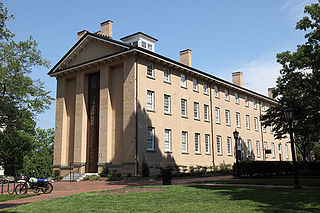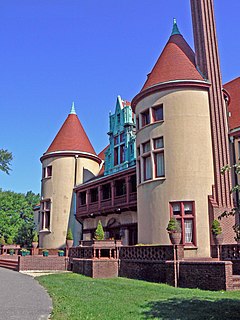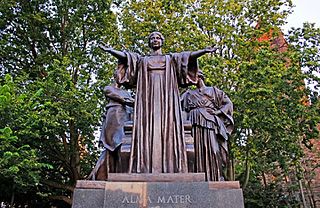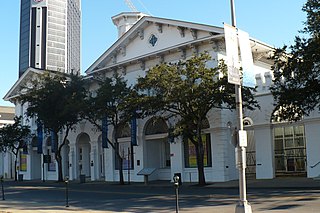
The Village of Hamilton is a village located within the town of Hamilton in Madison County, New York, United States. It is the location of Colgate University and has a population at 4,239 at the 2010 census. The 2017 movie Pottersville starring Michael Shannon and Judy Greer was filmed here.

Colgate University is a private liberal arts college in Hamilton, New York. Founded in 1819, Colgate enrolls nearly 3,000 students in 56 undergraduate majors that culminate in a Bachelor of Arts degree; it also enrolls a dozen students in a Master of Arts in Teaching program.

William Penn University is a private university in Oskaloosa, Iowa. It was founded by members of the Religious Society of Friends (Quakers) in 1873 as Penn College. In 1933, the name was changed to William Penn College, and finally to William Penn University in 2000.

Old East is a residence hall located at the north part of campus in University of North Carolina at Chapel Hill. When it was built in 1793, it became the first state university building in the United States. The Wren Building at the College of William & Mary in Williamsburg, Virginia, was built in 1695, but William and Mary did not become a public university until 1906.

Archmere Academy is a private Roman Catholic college preparatory school located in Claymont, Delaware, United States. It enrolls approximately 500 students. The academy is co-educational and is run independently within the Roman Catholic Diocese of Wilmington.

Coindre Hall, originally called West Neck Farm, is a 40-room, 80,000-square-foot (7,400 m2) mansion in the style of a medieval French château constructed in 1912 for pharmaceutical magnate George McKesson Brown.

Connecticut Hall is a Georgian building on the Old Campus of Yale University. Completed in 1752, it was originally a student dormitory, a function it retained for 200 years. Part of the first floor became home to the Yale College Dean's Office after 1905, and the full building was converted to departmental offices in the mid-twentieth century. It is currently used by the Department of Philosophy, and its third story contains a room for meetings of the Yale Faculty of Arts & Sciences, the academic faculty of Yale College and the Graduate School.

The Main Quadrangle at the University of Illinois at Urbana–Champaign comprises the main campus of the university. It is a major quadrangle surrounded by buildings of the College of Liberal Arts and Sciences (LAS) and is the center of campus activities.

The Northside United Methodist Church is a historic Methodist church in the Northside neighborhood of Cincinnati, Ohio, United States. Constructed in the 1890s for a congregation more than sixty years old, the building has been named a historic site.

The Main Building of Vassar College is the oldest surviving building on its campus in Poughkeepsie, New York, and the center of academic life. It was built by James Renwick, Jr. in the Second Empire style in 1861, the second building in the history of what was one of America's first women's colleges. It is one of the earliest, largest, and most important examples of Second Empire architecture in the United States and is a National Historic Landmark for its architecture and educational significance. At the time of its completion, the structure contained the most interior space of any building in the United States, and housed the entire college, including dormitories, libraries, classrooms, and dining halls. Currently, the first and second floors house campus administration while the remaining three house student rooms.

Old City Hall, also known as the Southern Market, is a historic complex of adjoining buildings in Mobile, Alabama, that currently houses the History Museum of Mobile. The complex was built from 1855 to 1857 to serve as a city hall and as a marketplace. It was declared a National Historic Landmark in 1973, as a rare well-preserved example of a 19th-century multifunction civic and commercial building.

University of Wisconsin Science Hall is a building on the campus of the University of Wisconsin–Madison. It is significant for its association with Charles R. Van Hise, "who led the Department of Mineralogy and Geology to national prominence" and then served as president of the university. The building was constructed in 1888. It was declared a National Historic Landmark in 1993.
Delaware College of Art and Design (DCAD) was founded in 1997 through a partnership between the Pratt Institute and the Corcoran College of Art and Design. DCAD's mission is to educate talented and committed students to become art makers, idea generators, problem solvers, and visual communicators who can redefine the way we perceive and experience the world around us. DCAD's associate of fine arts (AFA) degree program is offered in five disciplines: Animation, Fine Arts, Graphic Design, Illustration and Photography. Apart from the traditional disciplines of the fine artist, these include opportunities in publishing, marketing, computer graphics, advertising, packaging, display design, and photography. In addition to studio courses, courses in art history and writing and literature (combined) complete the curriculum. Most students transfer to other colleges that offer the BFA degree. The College is independently accredited regionally by the Middle States Commission on Higher Education and nationally by the National Association of Schools of Art and Design.

Estey Hall is a historic building on the campus of Shaw University in Raleigh, North Carolina. It was the first building constructed for the higher education of African-American women in the United States. Built in 1873, Estey Hall is the oldest surviving building at Shaw, which is the oldest historically black college in the South and was the first institution of higher learning established for freedmen after the Civil War. The building, originally known as "Estey Seminary," was named in honor of Jacob Estey, the largest donor to the construction project. Estey Hall, located in the East Raleigh-South Park Historic District, was listed on the National Register of Historic Places in 1973 and is a Raleigh Historic Landmark.

There are 68 properties listed on the National Register of Historic Places in Albany, New York, United States. Six are additionally designated as National Historic Landmarks (NHLs), the most of any city in the state after New York City. Another 14 are historic districts, for which 20 of the listings are also contributing properties. Two properties, both buildings, that had been listed in the past but have since been demolished have been delisted; one building that is also no longer extant remains listed.

The University of Arkansas Campus Historic District is a historic district that was listed on the National Register of Historic Places on September 23, 2009. The district covers the historic core of the University of Arkansas campus, including 25 buildings.

The West Union School is a historic one-room school located near the village of Norwich in eastern Muskingum County, Ohio, United States. Situated along County Road 200 south of the village, the school was erected in 1858. It replaced an earlier log school building; both structures occupied land on the property of pioneer farmer George Richey.

Strang School District No. 36, or the Strang Public School, is a historic school located in Fillmore County, Nebraska, in the village of Strang. The school is one of the two sites listed on the National Register of Historic Places in the village of Strang. The school building is a small, two-story, brick public schoolhouse, which was built to replace the schoolhouse that was previously located on that site. The schoolhouse was built between 1929 and 1930, and replaced the previous schoolhouse, which burned down in 1928. The schoolhouse still retains all original building materials. The school served high school students from 1930 to 1951, and still functions as a school today, serving grades K–8. The NRHP listing also includes a flagpole located outside the schoolhouse, and five pieces of playground equipment.

The Administration/Science Building, originally known as Science Hall, is a building on the campus of Arizona State University in Tempe, Arizona. It is the second-oldest building on campus, constructed in 1909. It currently houses the University Club, a members-only institution open to faculty, staff and community members.

The Old Arkansas City High School, now known as Ireland Hall and part of the Cowley Community College campus, is located at 300 W. Central Street in Arkansas City, Kansas. It was built in 1890-91. It was listed on the National Register of Historic Places in 1974.























